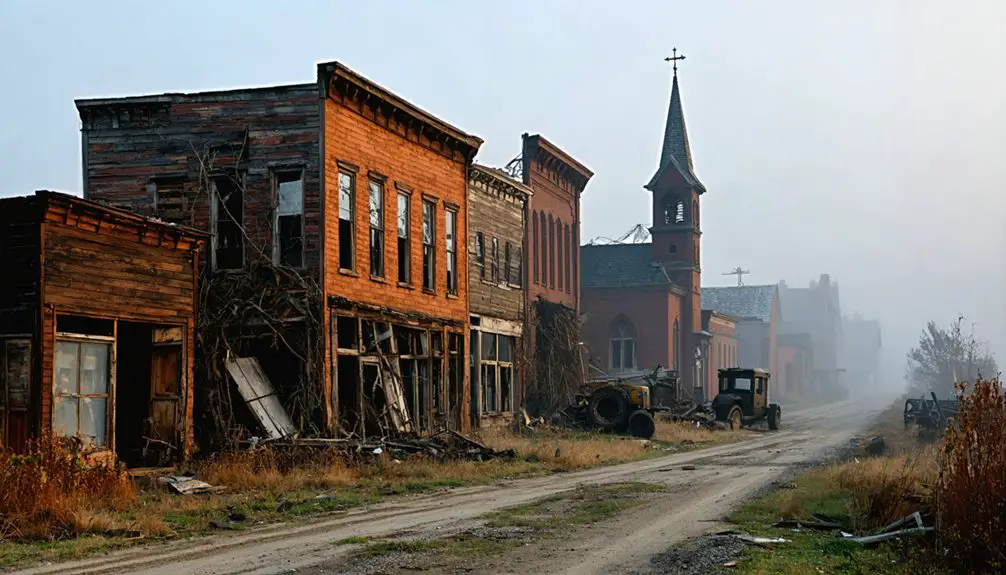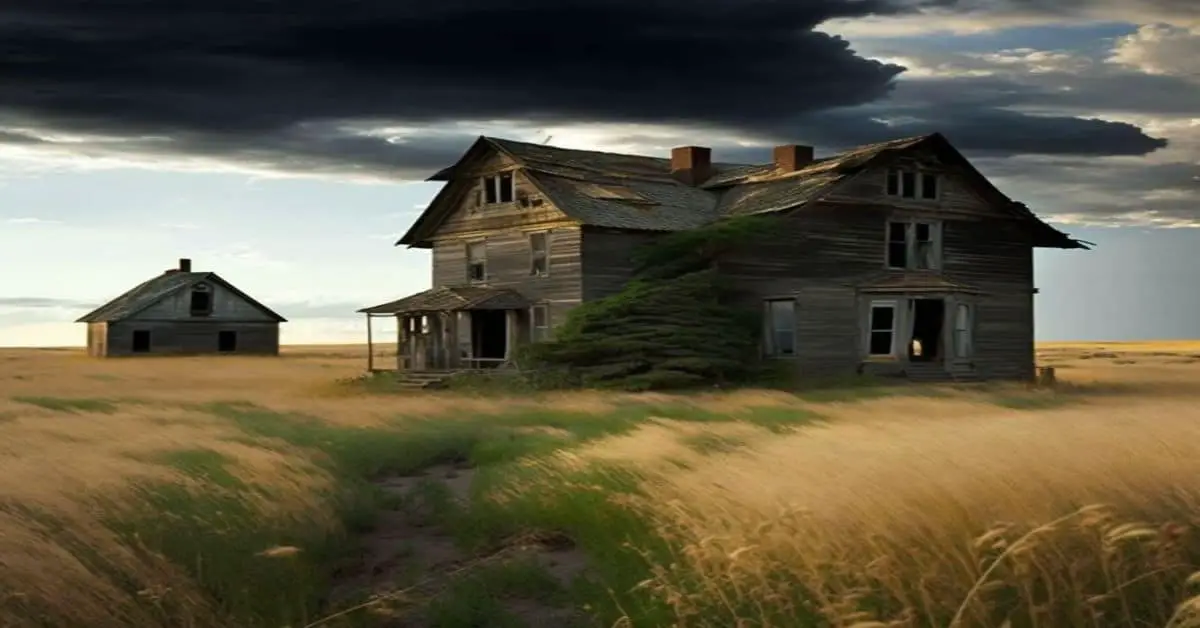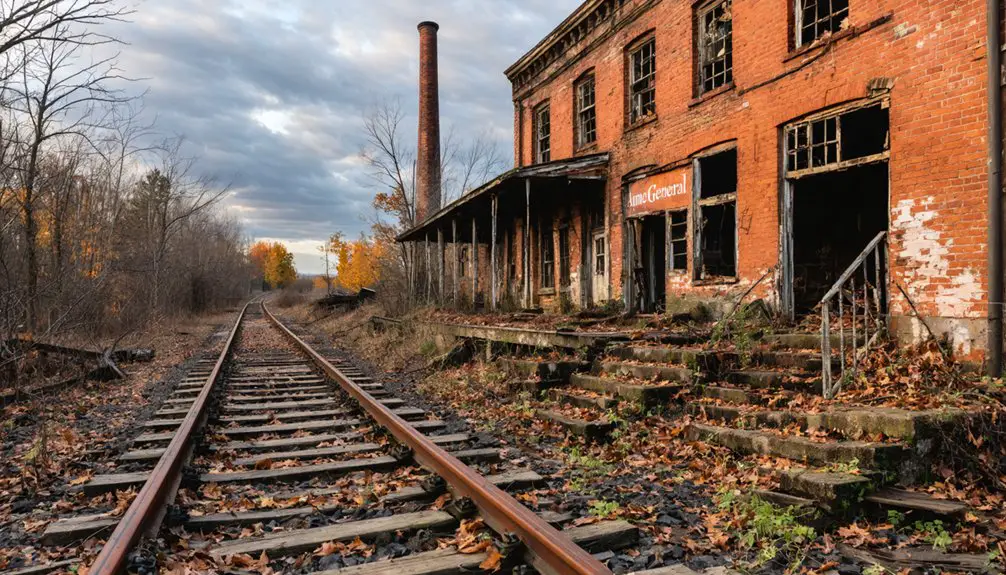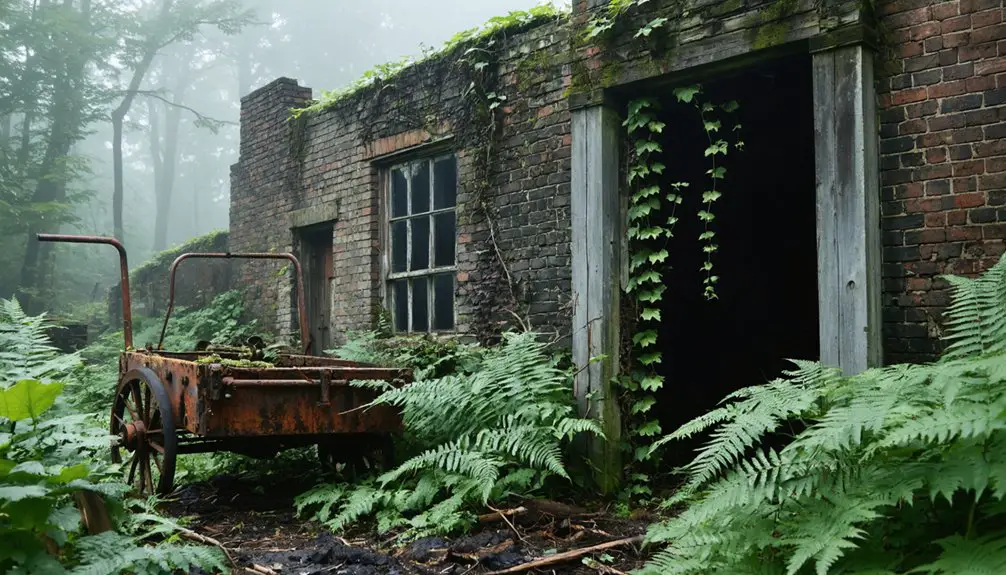You’ll find the remnants of Johnetta, Pennsylvania nestled in Armstrong County, where 156 company houses once housed workers for the Pittsburgh-Buffalo Company‘s massive brick manufacturing operation. Founded in 1892, this company town thrived with modern amenities, including an amusement hall, church, and schoolhouse. By 1920, the brick plant’s closure led to Johnetta’s abandonment, but today’s ruins reveal fascinating traces of early 20th-century industrial life and community dynamics.
Key Takeaways
- Johnetta was established in 1892 by the Pittsburgh-Buffalo Company and officially dissolved in 1930, transforming from a thriving industrial town to abandonment.
- The town’s economy centered around brick manufacturing, producing over 100,000 bricks daily through the United States Sewer Pipe Company.
- At its peak, Johnetta housed 662 residents with company-provided amenities including a store, schoolhouse, church, and amusement hall.
- The site contains remains of 140 frame houses and 16 brick residences, with visible foundations and tree-lined streets from the original layout.
- The ghost town’s ruins preserve archaeological evidence of early 20th-century industrial life and clay mining operations in Pennsylvania.
The Rise of a Company Town (1892-1905)
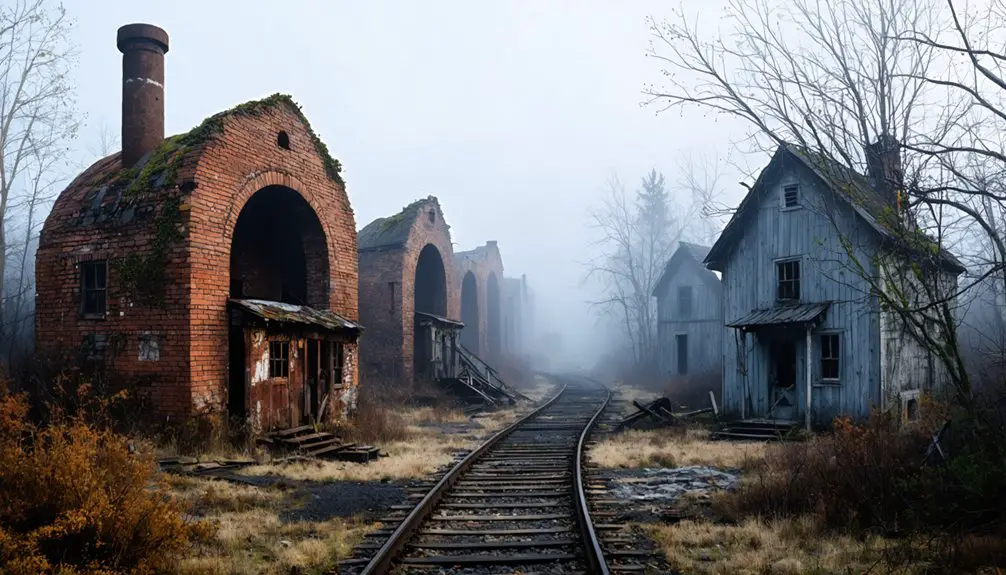
As the Pittsburgh-Buffalo Company sought to capitalize on the region’s rich natural resources, they established Johnetta in 1892 along a high bluff overlooking the Allegheny River. The company town, named after company president John H. Jones’s daughter, quickly grew into a thriving industrial settlement with 140 frame houses and 16 brick residences for its workforce. For clarity in historical records, Johnetta is listed as a place name disambiguation, helping distinguish it from other similarly named locations.
You’ll find the town’s early planning reflected a commitment to worker comfort, with homes featuring large garden plots and streets adorned with fruit and shade trees. The community’s social life centered around an amusement hall that provided various recreational activities for residents.
The workforce dynamics centered around 500 employees who enjoyed modern amenities unusual for remote industrial towns, including gas heating from company wells, water supply, and sewerage systems.
Life Along the Allegheny Valley
While nestled on a high bluff above the Allegheny River, Johnetta thrived as more than just an industrial hub, developing into a vibrant community with modern amenities unusual for its time.
Perched high above the Allegheny River, Johnetta flourished beyond its industrial roots into a progressive community with remarkable modern conveniences.
You’d find spacious homes with garden plots, streets lined with fruit and shade trees, and the historical significance of the Johnetta Memorial Church where Rev. Walter Kennedy led the congregation.
The community dynamics revolved around abundant recreation at the amusement hall, where you could enjoy bowling, billiards, and roller skating.
Your home would’ve had natural gas heating from company wells, along with modern water and sewerage systems – rare luxuries for company towns of that era.
The Allegheny Valley Railroad connected you to neighboring settlements like Aladdin and Bagdad, making Johnetta a well-connected stop along this essential transportation corridor.
The WeRelate community platform offers opportunities for users to contribute historical information about this once-thriving town.
The Pittsburgh-Buffalo Company Legacy
Looking back at the Pittsburg & Buffalo Company‘s influence in Johnetta, you’ll find a demonstration to early 20th-century industrial innovation through their 1899 mine development and subsequent expansion.
The company’s success transformed the region through carefully planned company towns, where they controlled housing, stores, and community facilities while extracting valuable coal deposits. Much like their namesake city of Buffalo, New York, the company established itself as a major transportation and industrial hub.
Founded by the enterprising Jones family from Wales, the company built an impressive industrial empire stretching across Pennsylvania and West Virginia.
You can trace their lasting impact through the remaining industrial ruins and the heritage of families who lived under the company’s strict oversight of both work and daily life.
Industrial Growth and Success
During the early 1900s, the Pittsburgh-Buffalo Company emerged as a dominant industrial force after James Jones and his five sons incorporated the business in 1903. From their headquarters in Pittsburgh’s Frick Building, they transformed the region’s community dynamics through ambitious industrial expansion and economic shifts.
The company’s remarkable industrial achievements included:
- Acquiring 6,000 acres of prime coal rights in Washington County, PA
- Establishing the “most modern Bituminous mine in the world” at Marianna
- Operating the United States Sewer Pipe Company plant, producing over 100,000 bricks daily
- Creating extensive railroad infrastructure to transport coal efficiently
You’ll find their legacy in the high-quality Kittanning clay products, which supplied North American markets with superior face bricks, pavers, and sewer pipes. The company demonstrated its commitment to workers by providing gas heating from wells to all employee residences.
Their industrial prowess supported a workforce of nearly 1,000 employees across mining and manufacturing operations.
Community Life and Control
The Pittsburgh-Buffalo Company’s influence extended far beyond industrial operations, shaping every aspect of daily life in Johnetta. You’d find the Jones family’s control evident in every corner of town, from the gas-heated homes to the company-maintained water systems.
While residents enjoyed modern amenities and recreational facilities, these comforts came with strings attached through social control and economic dependency.
The community dynamics reflected this complex relationship. You could gather at the amusement hall for bowling or skating, worship at the Memorial Church under Rev. Kennedy’s guidance, or tend to your garden plot beside your company-owned home.
While these features enhanced quality of life, they also reinforced the company’s paternalistic grip on the community, as you’d rely on them for both employment and basic services.
Mining the Kittanning Clay Deposits
You’ll find the Lower Kittanning clay deposits were vital to Johnetta’s early industrial development, with their superior plastic properties making them ideal for brick and tile manufacturing.
The extensive clay beds, varying from one to fifteen feet thick, supported local brickworks that contributed markedly to the region’s construction boom and infrastructure projects. The abundant flint clay deposits at Johnetta made it one of Armstrong County’s largest clay mining centers.
The mining of these valuable deposits often occurred alongside coal extraction, with surface excavation methods similar to those used in iron ore extraction, creating a robust local industry that helped build Pennsylvania’s towns and cities.
Clay Mining Operations
Mining operations targeting Kittanning clay deposits played an essential role in Johnetta’s industrial heritage, with extraction efforts dating back to the 1800s.
You’ll find these valuable clay deposits varying in thickness from 1 to 15 feet, with the Lower Kittanning clay being particularly extensive. The clay’s characteristics ranged from plastic to non-plastic, determining its workability and industrial applications.
Key aspects of Johnetta’s clay mining operations included:
- Surface stripping techniques focused on extracting fire clays beneath coal seams
- Integration with surrounding coal and iron ore extraction activities
- Progressive shift from shallow workings to deeper mining methods
- Careful management of roof stability and water infiltration challenges
The extracted clay supported critical industries, providing raw materials for brick manufacturing, furnace linings, and refractory products essential to the region’s economic growth.
Local Brick Production Impact
Established in 1898, Johnetta’s brick manufacturing plant quickly became America’s largest facility of its kind, producing an impressive 100,000 bricks daily. The plant’s brick innovation centered on utilizing pure Kittanning clay deposits, creating tough, vitrified products that proved impervious to water and frost damage.
You’ll find Johnetta’s economic sustainability reflected in its workforce of 400-450 employees, who helped produce everything from paving bricks to high-grade face bricks and sewer pipes.
The plant’s impact extended beyond mere production – it transformed the town itself. Workers lived in 282 company-built homes, featuring modern amenities like indoor plumbing and electricity.
The plant’s influence reached across the United States and Canada, with its distinctive yellow and reddish-brown bricks helping construct industrial sites like the Alcoa plant in New Kensington.
Daily Life and Community Amenities
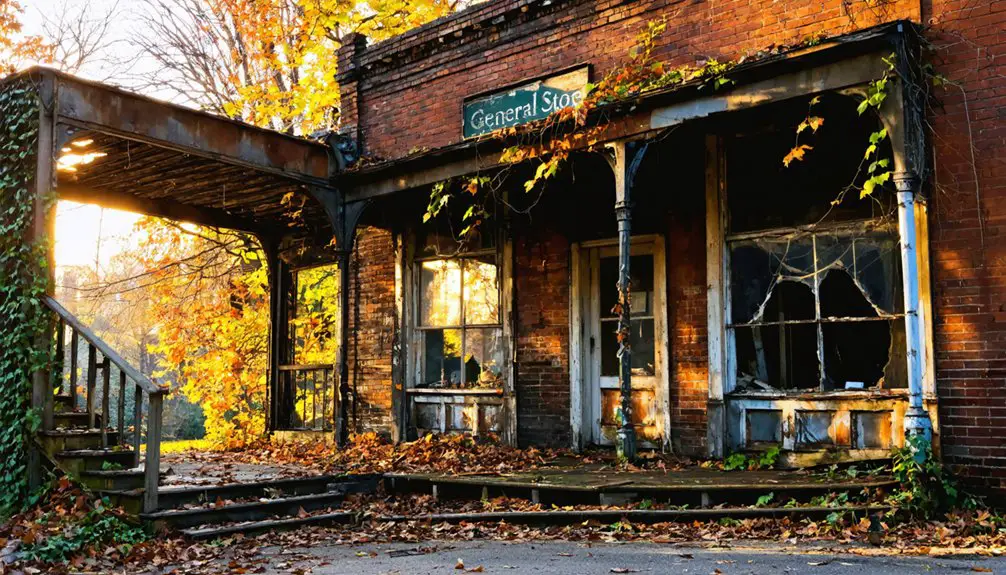
Life in Johnetta centered around a robust network of company-provided amenities that served its peak population of 662 residents.
You’d find everything needed for a self-sufficient lifestyle, from essential utilities to recreational spaces that fostered community gatherings.
The company guaranteed you’d access to:
- A well-equipped amusement hall featuring bowling alleys, billiards, and a large roller skating rink
- Modern utilities including water, sewerage, and gas heating from company wells
- A local store stocked with daily necessities
- A schoolhouse and the Johnetta Memorial Church led by Rev. Walter Kennedy
You’d enjoy spacious housing plots perfect for personal gardens, with streets lined by fruit and shade trees.
Like many communities in Western Pennsylvania’s Rust Belt, Johnetta’s population steadily declined as the coal industry faded.
Similar to Scotia’s close-knit culture, residents developed strong community bonds through shared experiences and daily interactions.
The tight-knit community regularly gathered for social events and meetings in these shared spaces.
Architecture and Housing Development
In Johnetta’s residential landscape, you’ll find the remains of 140 frame houses and 16 brick residences that once stood proudly along tree-lined streets overlooking the Allegheny River.
Similar to Summerfield’s town planning which showed surprisingly well-preserved sidewalks, Johnetta’s streets were carefully laid out with sturdy foundations and walkways that enhanced the community’s walkability.
The frame houses represented typical late 19th-century construction methods, while the brick homes, built with materials from the local Johnetta brick plant, were likely reserved for company officials and higher-status residents.
Each home sat on a generous plot that provided space for personal gardens, reflecting the town’s thoughtful design that balanced industrial efficiency with residents’ need for self-sufficiency.
Residential Layout Patterns
Situated on a high bluff overlooking the Allegheny River valley, Johnetta’s residential layout reflected thoughtful urban planning that balanced worker comfort with industrial efficiency.
The community design incorporated spacious residential gardens and generous land plots around each home, creating a semi-rural atmosphere that gave residents freedom to cultivate their own produce.
You’ll find evidence of forward-thinking infrastructure in:
- Gas heating from company wells powering all homes
- Town-wide water and sewerage systems
- Streets lined with fruit and shade trees
- Strategic placement of community facilities within walking distance
This thoughtful arrangement accommodated approximately 140 frame houses and 16 brick residences, housing a population of 662.
The layout created natural boundaries between living spaces while maintaining accessibility to work areas and social venues.
Housing Materials and Design
The architectural character of Johnetta emerged through a thoughtful blend of locally-sourced materials and practical design elements.
You’ll find that housing aesthetics varied between the 140 wood-framed houses and 16 brick residences, with the distinctive reddish-brown bricks produced from high-grade Kittanning clay at the local plant between 1900 and 1920.
The community design prioritized quality of life, positioning homes on a high bluff overlooking the Allegheny valley.
Each residence featured generous garden plots, while tree-lined streets enhanced the town’s appeal.
You’d appreciate how the infrastructure incorporated local resources, with houses heated by the company’s own gas wells.
This self-sufficient approach extended to municipal services, including water and sewerage systems, making Johnetta a model of early 20th-century planned community development.
Industrial Operations and Economic Base
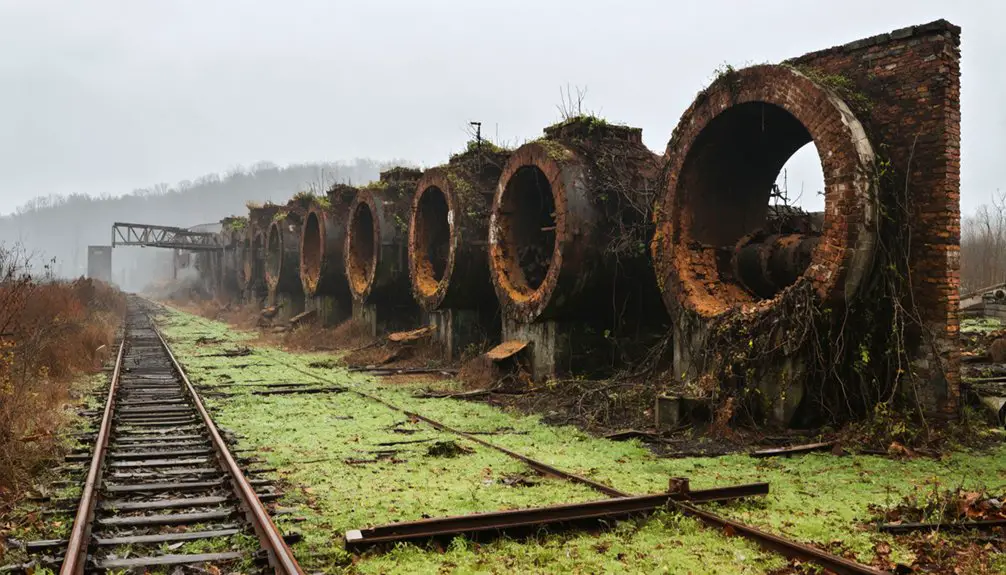
Founded in 1892 after local coal deposits were exhausted, Johnetta’s industrial identity emerged from the discovery of a substantial 15-foot clay seam that sparked the establishment of the United States Sewer Pipe Company.
This hub of industrial innovation became one of America’s largest brick manufacturing operations, demonstrating remarkable economic sustainability through:
- Daily production exceeding 100,000 bricks and high-grade sewer pipes
- Strategic shipping via Allegheny River and railroad networks to U.S. and Canadian markets
- On-site gas wells providing 80 pounds per square inch pressure for operations
- Development of the Johnetta Foundry & Machine Company, manufacturing essential mining equipment
The facility’s continuous operation, supported by 500 workers and extensive infrastructure, established Johnetta as a powerhouse in America’s industrial landscape until Pittsburgh Plate Glass Company’s acquisition in the 1920s.
The Golden Years of Brick Production
During its peak years of operation, Johnetta’s brick manufacturing facility emerged as America’s largest producer, processing the region’s prized Kittanning clay into over 100,000 bricks daily.
At its height, Johnetta’s massive facility dominated America’s brick industry, transforming local Kittanning clay into 100,000 daily masterpieces.
You’d find the plant working around the clock, extracting clay from a 15-foot-thick seam beneath the Kittanning coal deposits that stretched across 2,400 acres.
The plant’s production techniques yielded exceptional brick quality, creating products that were impervious to water and resistant to frost.
You could see the skilled workforce of 400-450 men crafting various brick types, from high-grade face bricks to durable pavers and sewer pipes.
These products served markets throughout the U.S. and Canada, with many becoming integral parts of major projects like the Alcoa plant in New Kensington.
The Path to Abandonment (1920-1930)
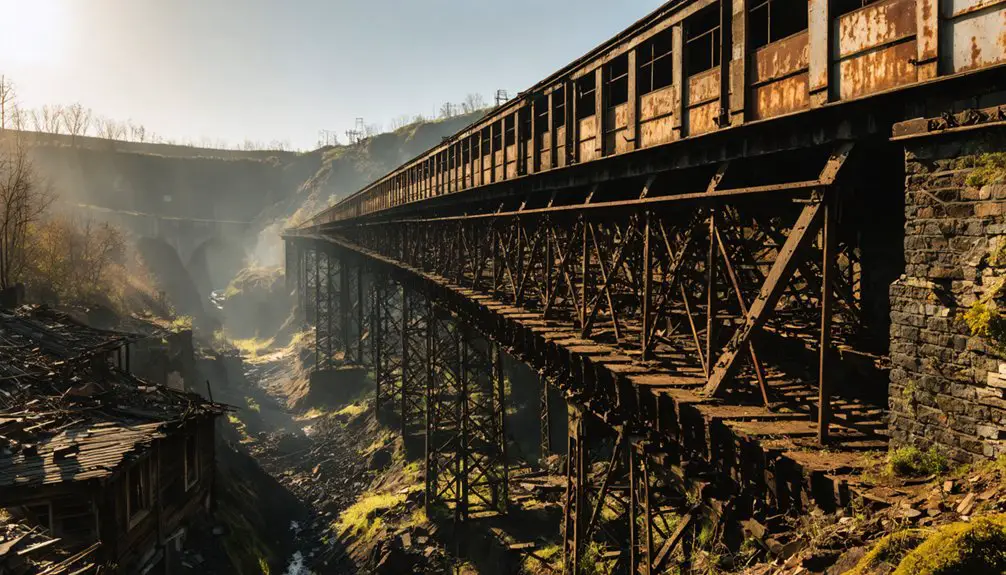
Despite its remarkable success in brick production, Johnetta’s industrial prosperity came to an abrupt end in 1920. The closure of the brick-making plant marked the beginning of severe economic hardship, as the Pittsburgh-Buffalo Company’s operations declined sharply.
You would’ve witnessed a dramatic community decline as the town’s population of 662 dwindled rapidly.
Here’s what sealed Johnetta’s fate:
- The depletion of local coal and clay resources made mining unprofitable
- Market demand for clay products plummeted throughout the 1920s
- The post office closed in 1929, severing crucial communication links
- The borough officially dissolved in 1930, ending Johnetta’s administrative existence
Worker housing stood empty, social venues shuttered, and utility services deteriorated.
As families sought opportunities elsewhere, Johnetta transformed from a bustling industrial hub into an abandoned ghost town.
Remnants and Archaeological Significance
While Johnetta’s buildings have largely crumbled since its 1930 abandonment, the town’s physical remnants tell a rich archaeological story.
You’ll find traces of 140 frame houses and sixteen brick residences that once crowned the Allegheny River bluff. Archaeological findings include foundations, industrial debris from clay mining, and remnants of the United States Sewer Pipe Company’s operations.
The historical context reveals itself through surviving elements of a planned industrial community.
You can spot evidence of tree-lined streets, garden plots, and the unique gas heating infrastructure that once served residents. The town’s layout offers valuable insights into early 1900s company town planning, while scattered ruins of the Amusement Hall hint at workers’ leisure activities.
Despite decay, these remnants provide essential data about early 20th-century industrial life.
Frequently Asked Questions
What Happened to the Residents After the Town Was Abandoned?
When 662 people lost their jobs, you’ll find most residents’ migration followed typical Rust Belt patterns – relocating to nearby urban centers or industrial cities for new manufacturing work, leaving behind empty properties.
Are There Any Surviving Photographs of Johnetta During Its Peak Years?
You’ll find limited historic documentation and visual archives of Johnetta’s peak years. While some photographs likely exist in regional collections or private holdings, there’s no widely accessible extensive photographic record.
Can Visitors Safely Access and Explore the Former Town Site Today?
You shouldn’t explore Johnetta without proper permissions and safety guidelines, as the site presents serious hazards from abandoned mines, unstable ground, and possible toxic gases. Limited visitor experiences are possible from public roads.
Did Any Notable Events or Disasters Occur in Johnetta’s History?
You won’t find notable disasters or dramatic historical events in Johnetta’s records. The town’s story ended quietly through economic decline when the brick plant closed, leading to its 1930 dissolution.
What Became of the Industrial Equipment When Operations Ceased?
You’ll find most industrial relics were sold as scrap or relocated to other plants, while some equipment was abandoned on-site. Without preservation efforts, the machinery’s fate mirrored many ghost towns’ decline.
References
- https://en.wikipedia.org/wiki/Johnetta
- https://www.gilpintwp.com/history.html
- https://www.youtube.com/watch?v=inRD6vYBy8M
- https://en.wikipedia.org/wiki/List_of_ghost_towns_in_Pennsylvania
- https://www.youtube.com/watch?v=HHPt6Tbbx7E
- https://www.werelate.org/wiki/Place:Johnetta
- https://triblive.com/local/valley-news-dispatch/remember-when-johnetta-was-once-a-thriving-town-in-the-alle-kiski-valley/
- https://www.angelfire.com/oz/madd/a/johnetta.html
- https://armstrongtrails.org/railroad-history/
- https://www.coalcampusa.com/westpa/klondike/marianna/marianna.htm
